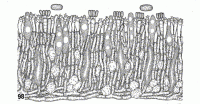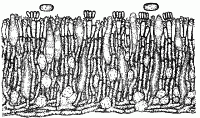|
 Aleurodiscus aberrans Aleurodiscus aberrans
SynonymsAcanthophysium aberrans
BiostatusPresent in region - Indigenous. Endemic
Images (click to enlarge)
Caption: FIG. 98. Acanthophysium aberrans. Showing crystals embedded among erect hyphae
of the intermediate layer, gloeocystidia. acanthophyses, and oblong spores. | 
Caption: Pl. 26, fig. 1. Aleurodiscus aberrans, x 1. | 
Caption: FIG. 9. Aleurodiscus aberrans. Transverse section, showing gloeocystidia and acanthophyses,
x 550. Spores, x 1000. |
Article: Cunningham, G.H. (1963). The Thelephoraceae of Australia and New Zealand. New Zealand Department of Scientific and Industrial Research, Bulletin 145: 359 p. Wellington:.
Description: Hymenophore annual, adherent, ceraceous-cretaceous, at first appearing as small
linear scattered colonies 2-5 x 1-2 cm, becoming coalesced forming linear effused
areas to 5 cm long; hymenial surface white, remaining so or becoming cream, or
occasionally sulphur-yellow, at length deeply areolately creviced; margin thinning out,
fibrillose, white, adherent. Context white, 120-160 µ thick, basal layer narrow, of
mainly parallel hyphae, intermediate layer occupying the greater part of the context, of
closely arranged erect hyphae soon cemented by their walls to form a
pseudoparenchyma, embedding masses of crystals; generative hyphae forming the
bulk of the hymenial layer, clavate or fusiform, to 6 µ, diameter, with the apical
region covered with several (5-14) blunt processes 2-3 µ long. Gloeocystidia arising
in the base of the context and subhymenium, some projecting slightly, fusiform or
flexuous-cylindrical, 45-80 x 8-10 µ, apices rounded. Hymenial layer to 50 µ deep, a
loose palisade of basidia, paraphyses, acanthophyses, and gloeocystidia. Basidia
subclavate, 16-25 x 5-6 µ, bearing 4 spores; sterigmata slender, erect, to 6 µ long.
Paraphyses subclavate, scanty, 12-18 x 4-5 µ. Spores elliptic-oblong with rounded
ends, apiculate, 7-9 x 4-5 µ, walls smooth, hyaline, 0.2 µ thick, amyloid, often
adhering in fours.
Habitat: HABITAT: Effused on bark of dead stems and branches.
Distribution: DISTRIBUTION: New Zealand.
Notes: Separated from other species bearing clavate acanthophyses by the small basidia,
smooth elliptic oblong spores, and absence of clamp connections. The species
resembles `Aleurodiscus' cerussatus (Bres.) H. & L. in surface features, presence of
gloeocystidia, apically spined acanthophyses and smooth elliptical spores. It differs in
that basidia are smaller, clamp connections absent, and spores are smaller and of
different shape. In most collections the hymenial surface is white and remains so or
changes to cream on drying; the collection from Coriaria arborea is rich cream with
sulphur yellow areas where growing in bark crevices.
Article: Cunningham, G.H. (1956). Thelephoraceae of New Zealand. Part XI. The genus Aleurodiscus. Transactions of the Royal Society of New Zealand 84(2): 237-268.
Description: Hymenophore annual, resupinate, adnate, ceraceous-cretaceous, at first appearing as small
linear scattered colonies 2-5 x 1-2 mm, becoming coalesced forming linear effused areas to 5
cm long; hymenial surface white, remaining so or becoming cream, or occasionally sulphur
yellow, pruinose, at length deeply areolately creviced; margin thinning out, fibrillose, white,
adnate. Context white, 120-160 µ thick, basal layer narrow, of mainly parallel hyphae,
intermediate layer occupying the greater part of the context, of closely arranged upright
hyphae soon cemented by their walls to form a pseudoparenchyma, embedding masses of
crystals; generative hyphae to 6 µ diameter, walls l µ thick, hyaline, branched, septate,
without clamp connexions. Hymenial layer to 50 µ deep, a loose palisade of basidia,
paraphyses, acanthophyses and gloeocystidia. Basidia subclavate, 16-25 x 5-6 µ, 4-spored;
sterigmata slender, upright, to 6 µ long. Paraphyses subclavate, scanty, narrower and shorter
than the basidia. Acanthophyses forming the bulk of the hymenial layer, clavate or fusiform,
to 6lU diameter, with the apical region covered with several (5-14) blunt spines 2-3 µ long.
Gloeocystidia arising in the base of the context and subhymenium, some projecting slightly,
fusiform or flexuous-cylindrical, 45-80 x 8-10 µ, apices rounded, walls 0.25 µ thick. Spores
elliptic-oblong with rounded ends, apiculate, 7-9 x 4-5 µ, walls smooth, hyaline, 0.2 µ thick,
amyloid; often adhering in fours.
Habitat: HABITAT. Effused on bark of dead stems and branches.
Distribution: DISTRIBUTION. New Zealand.
Notes: Separated from other species present in this region by the clavate acanthophyses, abundant
gloeocystidia, small basidia, elliptical smooth spores and effused resupinate hymenophore
with a well developed intermediate layer. Arrangement of the context is similar to that of
most species of Corticium, and the small basidia and spores strengthen the resemblance. As
acanthophyses are present, and spores amyloid, the species has been treated as an
Aleurodiscus. Because of its unusual morphology for a member of this genus the specific
name has been given.
The species resembles A. cerussatus (Bres.) Hoehn. & Litsch. in surface features, presence of
apically spined acanthophyses, gloeocystidia and smooth elliptical spores. It differs in that
basidia are smaller, clamp connexions absent, and spores are smaller and of different shape.
In most collections the hymenial surface is white, and remains so or changes to cream on
drying; the collection from Coriaria is rich cream with sulphur yellow areas where growing
in bark crevices. It is identical in microfeatures.
This and the following species [Aleurodiscus sparsus] are resupinate and effused, with the
context composed of both basal and intermediate tissues. A. candidus, though colonies are
usually pulvinate, is treated under the resupinate section since it possesses a similar type of
context and colonies are sometimes coalesced and form resupinate areas. Species may be
divided into four sections according to the types of acanthophyses and dendrophyses.
Acanthophyses of A. aberrans are clavate with apices crowned with digitate processes or
spines, coralloid in A. coralloides, A. coronatus and A. sparsus, and botryose in A. botryosus.
Dendrophyses of somewhat simple type are present in A. acerinus, A. candidus, A. nivosus
and A. aurantius.
Article: Cunningham, G.H. (1963). The Thelephoraceae of Australia and New Zealand. New Zealand Department of Scientific and Industrial Research, Bulletin 145: 359 p. Wellington:.
Description: Hymenophore annual, adherent, ceraceous-cretaceous, at first appearing as small
linear scattered colonies 2-5 x 1-2 cm, becoming coalesced forming linear effused
areas to 5 cm long; hymenial surface white, remaining so or becoming cream, or
occasionally sulphur-yellow, at length deeply areolately creviced; margin thinning out,
fibrillose, white, adherent. Context white, 120-160 µ thick, basal layer narrow, of
mainly parallel hyphae, intermediate layer occupying the greater part of the context, of
closely arranged erect hyphae soon cemented by their walls to form a
pseudoparenchyma, embedding masses of crystals; generative hyphae forming the
bulk of the hymenial layer, clavate or fusiform, to 6 µ, diameter, with the apical
region covered with several (5-14) blunt processes 2-3 µ long. Gloeocystidia arising
in the base of the context and subhymenium, some projecting slightly, fusiform or
flexuous-cylindrical, 45-80 x 8-10 µ, apices rounded. Hymenial layer to 50 µ deep, a
loose palisade of basidia, paraphyses, acanthophyses, and gloeocystidia. Basidia
subclavate, 16-25 x 5-6 µ, bearing 4 spores; sterigmata slender, erect, to 6 µ long.
Paraphyses subclavate, scanty, 12-18 x 4-5 µ. Spores elliptic-oblong with rounded
ends, apiculate, 7-9 x 4-5 µ, walls smooth, hyaline, 0.2 µ thick, amyloid, often
adhering in fours.
Habitat: HABITAT: Effused on bark of dead stems and branches.
Distribution: TYPE LOCALITY: Mt. Te Aroha, Auckland, New Zealand.
DISTRIBUTION: New Zealand.
Notes: Separated from other species bearing clavate acanthophyses by the small basidia,
smooth elliptic oblong spores, and absence of clamp connections. The species
resembles `Aleurodiscus' cerussatus (Bres.) H. & L. in surface features, presence of
gloeocystidia, apically spined acanthophyses and smooth elliptical spores. It differs in
that basidia are smaller, clamp connections absent, and spores are smaller and of
different shape. In most collections the hymenial surface is white and remains so or
changes to cream on drying; the collection from Coriaria arborea is rich cream with
sulphur yellow areas where growing in bark crevices.
|